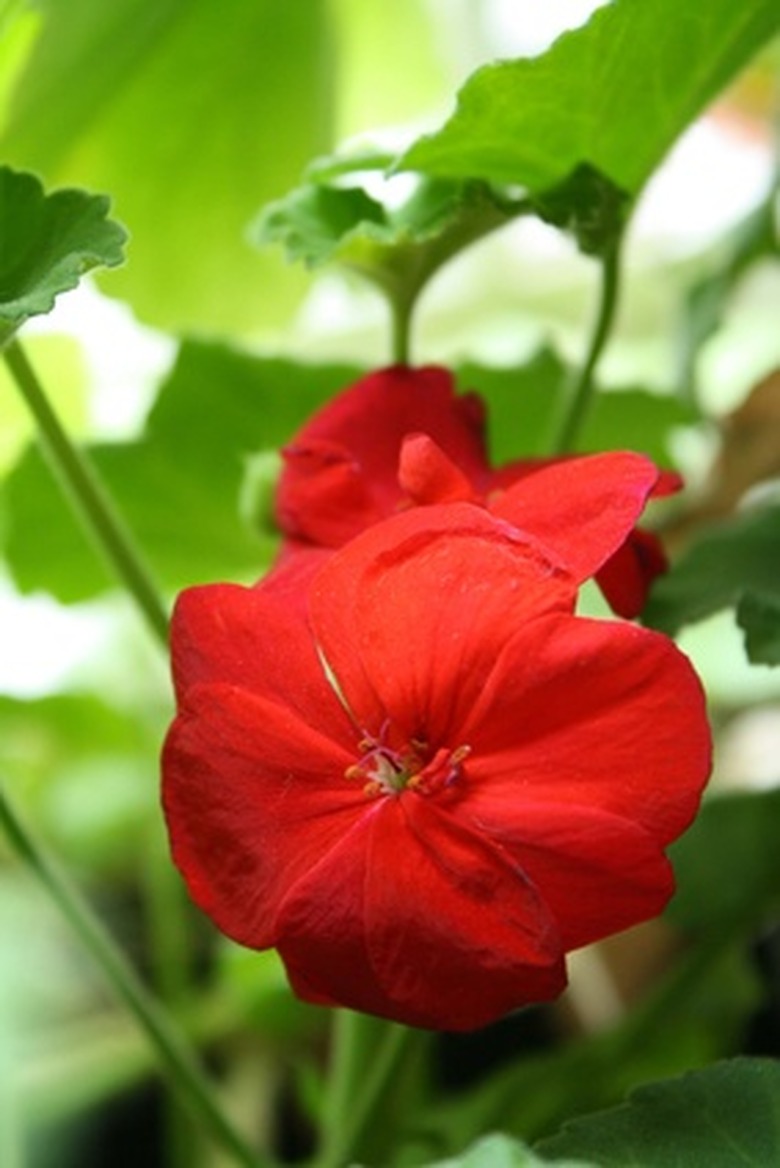How To Take Cuttings Of Geraniums Hydroponically
Things Needed
- Sharp craft knife or razor blade
- Wood scrap, 2-by-2 inches or larger
- Small glass or plastic container
- Commercial starter block or sand
- Seed tray with clear humidity dome
- Spray bottle of water
- Rubbing alcohol
Propagation of geraniums by cuttings is a fast way to produce many plants inexpensively. The new plants are identical to the mother, so choosing a healthy and vigorous mother plant is essential. Rooting plants hydroponically is similar to normal rooting conditions, but plants are placed into hydroponic growing medium rather than soil. When using commercial rooting materials, you will need to adjust the water for pH as recommended by the manufacturer. Use plain distilled water if rooting in sand.
Step 1
Remove the mother plant from the nutrient solution two to three days in advance. Water it heavily with water under the same pH and moisture conditions that you had been maintaining it with hydroponically.
- Propagation of geraniums by cuttings is a fast way to produce many plants inexpensively.
- Rooting plants hydroponically is similar to normal rooting conditions, but plants are placed into hydroponic growing medium rather than soil.
Step 2
Choose a growing medium. Rapid Rooters, Rockwool or Oasis cubes are effective, but clean sand works well also.
Step 3
Cut several holes in the bottom of a plastic cup, a few small holes will do the trick. Pre-soak the growing medium in distilled water and place it in the plastic cup. Punch a hole in the growing medium using a small twig or pencil.
Step 4
Prepare the rooting hormone according to package directions. Use rubbing alcohol to clean your hands, the craft knife and the scrap wood.
- Rapid Rooters, Rockwool or Oasis cubes are effective, but clean sand works well also.
- Punch a hole in the growing medium using a small twig or pencil.
Step 5
Back the stem with the scrap wood and slice cleanly through the stem using the knife. Choose a growing stem, approximately 3 inches long, with at least one leaf, two or more is best. Cut approximately 1/4 inch below a leaf node at a 45- to 60-degree angle. Cut off the leaves at the stem, using the knife, leaving only the leaves at the tip.
Step 6
Place the cutting into the prepared rooting hormone according to package directions, then poke it into the hole in the growing medium. Bury one-half to two-thirds of the stem in the growing medium. Push the growing medium around the stem to support it.
- Back the stem with the scrap wood and slice cleanly through the stem using the knife.
- Cut off the leaves at the stem, using the knife, leaving only the leaves at the tip.
Step 7
Put the cuttings in a domed seed tray and mist them with water from the spray bottle. Mist the inside of the clear dome and place the dome on the tray. Repeat the misting two or three times a day.
Step 8
Place the dome in filtered sunlight or under grow lights. Monitor the temperature under the dome and do not allow it to get too hot. Ideal temperature is between 72 and 80 degrees F.
Step 9
Water the cuttings with plain distilled water every other day. In very dry environments, water daily. Keep the growing medium moist, but not wet.
- Put the cuttings in a domed seed tray and mist them with water from the spray bottle.
- Ideal temperature is between 72 and 80 degrees F. Water the cuttings with plain distilled water every other day.
Step 10
Check the plants after a week by removing the dome and leaving it off for an hour or so. If the plants begin to wilt, mist and replace the dome. If the plants do not wilt, leave the dome off and stop misting but continue to water, keeping the plants moist.
Step 11
Move the plants to the hydroponic system when the cuttings are completely rooted, approximately two weeks after taking the cutting and begin watering with nutrient solution.
Tip
Do not fertilize the rooting plants. Fertilizer favors leaf growth, a nutrient poor rooting medium forces the plant to grow more roots to search for nutrients. As the roots develop, the lower leaves may turn yellow and die. Do not remove these leaves, allow them to stay on the plant until the plant is well rooted. The plant actually feeds off these dying leaves until the roots are well developed. Take more cuttings than you need to allow for a few failures. With care, most cuttings will take root, but take extra until you are sure of your success rate.
Warning
Be careful when using the knife or razor blade.
